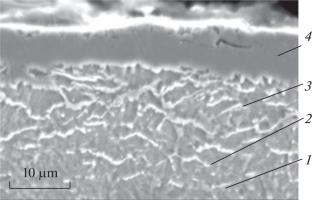Improvement of Wear Resistance of a Nitrided Layer of Machine Parts Made of Alloyed Steels by High Intensity and High Energy Methods
Abstract—
This article discusses the experimental results of wear resistance of machine parts made of alloyed steels, with nitrided layers, with structures formed with and without nitride mesh. It has been demonstrated that the nitrided layers with traditional structure under certain conditions of friction and wear do not completely exhibit their potentials of wear resistance as a consequence of disintegration of their fragments due to weakened intergranular boundaries in nitrided layer resulting from their oversaturation with nitrogen. The models of formation of structures of nitrided layers are schematically illustrated including their behavior during friction and wear. It has been mentioned that the use of high energy ion implantation at an ion energy of about 18–26 keV due to the occurrence of the long-range effect provides formation of radiation defects of a crystalline structure at a depth comparable with the thickness of a nitrided layer allowing it to significantly intensify nitrogen diffusion as well as to block grain boundaries, which inhibit diffusion processes in them. It has been determined that while intensive plastic deformation of the surface layer improves diffusion intensity, still, it can be efficiently applied only in combination with high energy ion implantation. The results of comparative wear tests are exemplified by screw pump rotors operating under conditions of intensive friction wear. It has been demonstrated that the absence of nitride mesh in a nitrided layer improves wear resistance of the nitrided layer by about 3–4 times.


 求助内容:
求助内容: 应助结果提醒方式:
应助结果提醒方式:


